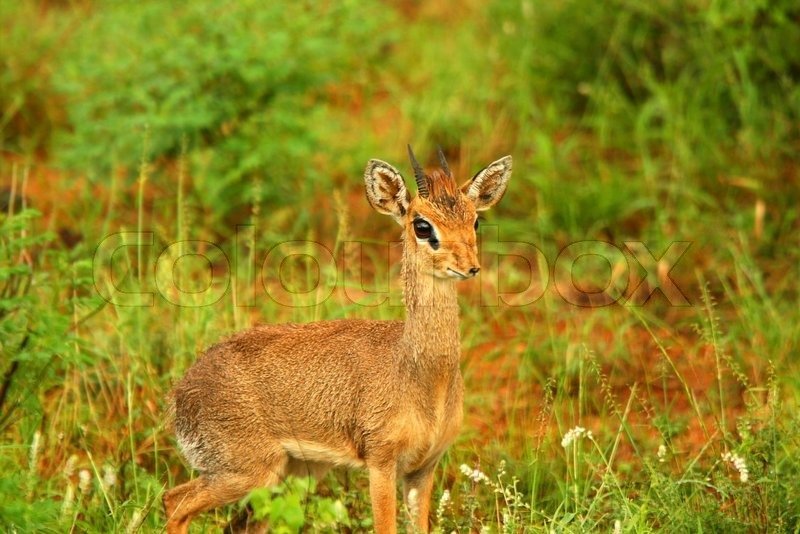
Dik-Diks are adorable little antelopes native to the eastern and southern regions of Africa. You might picture a larger animal when you hear the word “antelope,” but these creatures are quite petite. Imagine the size of a large dog, and you’re close! Their charming size and unique features make them one of nature’s delightful wonders. With their big, expressive eyes and delicate legs, Dik-Diks have a flair that’s hard to resist.
These animals belong to the genus Madoqua and are known for their distinctive features, like their long noses and large ears. But there’s more to these little guys than just their looks. They’re part of a larger framework in the ecosystem where they play vital roles, from being prey for larger predators to helping maintain the balance of plant life in their habitats.
Physical Characteristics
Dik-Diks might be small, but they pack a lot of personality in their compact frames. Typically, they stand about 30 to 40 centimeters tall and weigh roughly 5 to 10 kilograms. Their fur is usually a mix of brown and gray tones, providing excellent camouflage against the shrubs and grasses where they dwell. Interestingly, their long, pointed noses are not just for show; they help them regulate body temperature and smell food from a distance.
One of the most striking features of the Dik-Dik is its eyes. Large and round, they give these animals an almost cartoonish appearance, but they serve an essential purpose. The size allows for excellent peripheral vision, helping them spot predators like leopards or hyenas from afar. And let’s not forget about their slender legs, which are built for quick escapes! When danger lurks, they can dart away with surprising speed for their size.
Habitat and Distribution
You’ll find Dik-Diks primarily in the arid and semi-arid regions of eastern and southern Africa. They thrive in environments like savannas, scrublands, and woodlands, where they can hide among the dense vegetation. This habitat provides not only physical shelter but also a food source, with the leaves, buds, and fruits they enjoy grazing on. What makes them even more fascinating is their ability to adapt to challenging environments, often venturing into areas where food sources may be limited.
While they are found in various countries across Africa, their populations are concentrated in places like Kenya, Tanzania, and Namibia. They often make small territories, which they mark using scent from glands located near their eyes. Keeping their territories small helps them maintain access to vital resources while minimizing competition from other Dik-Diks. It’s a delicate balance, but one they navigate with ease.
Diet and Feeding Habits
Dik-Diks are herbivores, which means their diet consists purely of plant materials. They mostly graze on leaves, shoots, and fruits, and it’s fascinating how they select their meals. They prefer tender foliage and will often nibble at the same plants regularly. You might be surprised to learn that they can actually go for a long time without drinking water. Their bodies extract moisture from the fruits and leaves they consume, making them quite efficient in arid environments.
Interestingly, they’re also known to be selective eaters. This is not just a matter of preference; it’s a survival strategy. By choosing high-quality forage, they ensure they get enough nutrients to thrive in their often harsh surroundings. They typically feed in the early morning and late afternoon, staying alert during the day to avoid predators. It’s a constant balancing act of enjoying a meal while staying safe!
Behavior and Social Structure
Dik-Diks are solitary creatures by nature but can also be seen in pairs or small groups, especially during the mating season. They are typically monogamous, forming strong bonds with their partners. The male and female will often stay together for life, working as a team to defend their territory and raise their young. You might find them engaging in mutual grooming, which strengthens social bonds.
When it comes to communication, Dik-Diks have a variety of vocalizations that express different emotions or alerts. Their alarm call is a sharp, high-pitched sound that warns other Dik-Diks of potential danger. They’re also known to use body language, like snorting or stamping their feet, to signal when they feel threatened. This mix of vocal and physical cues showcases their intelligence and adaptability in the wild.
Reproduction and Lifespan
The breeding season for Dik-Diks typically coincides with the rainy season when food is plentiful. After a gestation period of about six months, a single calf is usually born. This calf is adorable and incredibly small, often weighing just a couple of kilograms! The mother is very protective and usually hides the calf in dense brush to keep it safe from predators. She’ll return to nurse and care for it, but she’s cautious about revealing its location.
A fascinating aspect of Dik-Dik reproduction is how quickly the young adapt. Within a few weeks, the calves can stand and walk, gradually learning to graze on their own. They gain independence faster than one might expect, typically joining their mother for food while observing their surroundings. In the wild, Dik-Diks can live up to 10 years, though their lifespan may be shorter in areas with higher predator activity.
| Size: | 30-40 cm tall |
| Weight: | 5-10 kg |
| Diet: | Herbivorous (leaves, shoots, fruits) |
| Habitat: | Savannas, scrublands, woodlands |
| Lifespan: | Up to 10 years |
| Gestation Period: | Approximately 6 months |
Conservation Status
As charming as Dik-Diks are, they face several threats that put their populations at risk. Habitat loss due to agriculture and urban development is one of the primary concerns. As people expand into natural areas, these little antelopes find themselves with fewer places to live and less food to eat. Additionally, poaching and hunting for bushmeat have also contributed to their decline in certain regions.
Conservation efforts are crucial to ensuring that Dik-Diks continue to thrive in the wild. Many organizations are working to protect their habitats and raise awareness about these animals. By establishing protected areas and promoting sustainable land use practices, we can help these delightful creatures remain a part of our world. After all, they enhance the biodiversity of their ecosystems, making them worth protecting.
Fun Facts About Dik-Diks
- Dik-Diks can leap up to 3 meters high when startled!
- The name “Dik-Dik” originates from the sound they make when alarmed.
- They have a strong pair bond and are known to engage in affectionate behavior.
- Despite their small size, they can be quite territorial.
FAQ
Where can I find Dik-Diks in the wild?
Dik-Diks are primarily found in eastern and southern Africa, especially in countries like Kenya, Tanzania, and Namibia. They thrive in bushy and shrubby environments such as savannas and woodlands. If you’re ever on a safari in these regions, keep your eyes peeled for these tiny antelopes!
Are Dik-Diks social animals?
While Dik-Diks are generally solitary, they do form pairs, particularly during the mating season. They often engage in affectionate behaviors and can be seen grooming each other. In some instances, you might spot a small group, but they are usually more comfortable on their own or with a mate.
What do Dik-Diks eat?
Dik-Diks are herbivores, mainly eating leaves, shoots, and fruits. They are selective feeders and prefer tender foliage. Interestingly, they can obtain much of the moisture they need from their food, allowing them to survive in arid environments without drinking water regularly.
What are the main predators of Dik-Diks?
When it comes to survival, Dik-Diks must be on the lookout for larger predators. Common threats include leopards, hyenas, and birds of prey. Their best defense is their speed and ability to hide in dense vegetation, allowing them to evade these predators.
How do Dik-Diks communicate with each other?
Dik-Diks communicate through a combination of vocalizations and body language. They produce various sounds, particularly sharp alarm calls when danger is near. They also use physical cues like snorting and foot stamping to convey messages to each other, showcasing their intelligence and social awareness.
How long do Dik-Diks live?
In the wild, Dik-Diks can live up to 10 years, though their lifespan may be shorter when they face numerous threats from predators. In protected environments or reserves, where they have less stress and more resources, they might live longer.
Can Dik-Diks survive in captivity?
Yes, Dik-Diks can survive in captivity, though they require specific care to thrive. Zoos and wildlife sanctuaries can provide suitable environments for them, mimicking their natural habitats. Proper diet, space to roam, and social interaction are crucial for their well-being.
Are Dik-Diks endangered?
While Dik-Diks are not currently classified as endangered, they do face threats from habitat loss and poaching. Conservation efforts are essential to ensure their long-term survival. Awareness and protection of their habitats can go a long way in keeping these lovely animals safe.
What adaptations do Dik-Diks have for survival?
Dik-Diks have several adaptations that help them survive in their environments. Their keen eyesight and excellent hearing allow them to detect predators early, while their small size and agility enable them to navigate quickly through their habitats. Their long noses also help regulate body temperature in hot climates, making them well-suited to their conditions.
How do Dik-Diks care for their young?
Dik-Dik mothers are very attentive to their calves. After giving birth, they hide the young in thick brush to protect them from predators. The mother returns frequently to nurse and care for the calf. As the young grow, they learn to graze alongside their mothers, gradually gaining independence.

